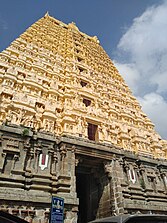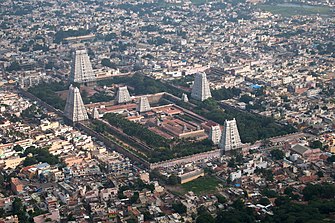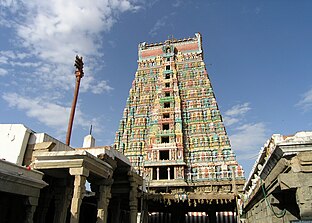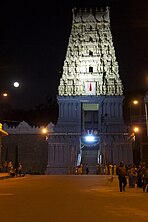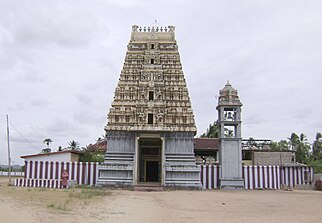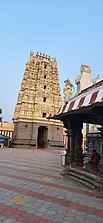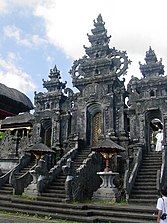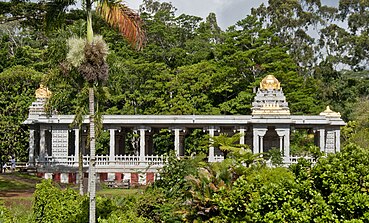Gopuram
A gopuram or gopura (
Ancient and early medieval temples feature smaller gopuram, while in later temples they are a prominent feature of
The gopuram's origins can be traced back to early structures of the
A large Dravidian-style temple, or koil, may have multiple gopurams as the openings into successively smaller walled enclosures around the main shrine, with the largest generally at the outer edges. The temple compound is typically square or rectangular with at least the outermost wall having gopuras, often from the four cardinal directions. The multiple storeys of a gopuram typically repeat the lower level features on a rhythmic diminishing scale.[5] The inner sanctum and its towering roof (the central deity's shrine) is also called the Vimanam, although in the south it is typically smaller than the gopurams in large temples.
Etymology
The
The Telugu derivation is from the two words : కోపు (Kōpu) and అరం (Araṁ) meaning "Top" and "to exist".[8]
An alternative derivation is from the
Dr. Sthapati explains the meaning of the words gopuram and vimanam thus. Vimanam means measure, indicating the number of measures made in the construction and design of that structure. Gopuram consist of two words, gawa and puram, meaning the place from which all the energy that exists in all living beings comes inside.[10]
Architecture

A gopuram is usually a tapering
The two tallest gopuras are both modern, at least in part. The
-
Thiruvannamalai
-
Thillai Nataraja Temple, Chidambaram
-
Kancheepuram
-
Simhachalam
-
Ayothiapattinam, Ramaswamy temple
-
Besakih, Bali
-
Betrayaswamy Temple
-
On left is a gopuram, to the right above the sanctum is vimana
See also
- List of tallest Gopurams
- Candi bentar, split gateways for Indonesian Hindu temples
- Paduraksa, greater gateways to inner and more sacred areas in Indonesian Hindu temples
Notes
- ^ a b "gopura". Encyclopædia Britannica. Retrieved 20 January 2008.
- ISBN 978-0-471-26892-5.
- ISBN 0-471-28451-3.
- ISBN 014027863X.
- ^ ISBN 0-226-53230-5.
- ^ Sellby, Martha A.; Indira Viswanathan Peterson (2008). Tamil geographies: cultural constructions of space and place in South India. SUNY Press.
- ^ S. Sundararajan (1991). Ancient Tamil country: its social and economic structure. Navrang.
- ^ Vaachaspathy (9 November 2020). Bangaru Nanelu.
- ISBN 9783447056199.
- ^ Sthapati, Dr. V. "Lecture at Brihadeeshwara temple (part 2)". You tube.
- ^ Harle, 320-325
- ^ "Towers" on temple website; Tamilwebworld
- ^ "Murudeshwar Temple Now Tallest Gopuram in Asia", April 2008
References
- Dallapiccola, Anna L. (2002). ISBN 0-500-51088-1.
- Harle, J.C., The Art and Architecture of the Indian Subcontinent, 2nd edn. 1994, Yale University Press Pelican History of Art, ISBN 0300062176



